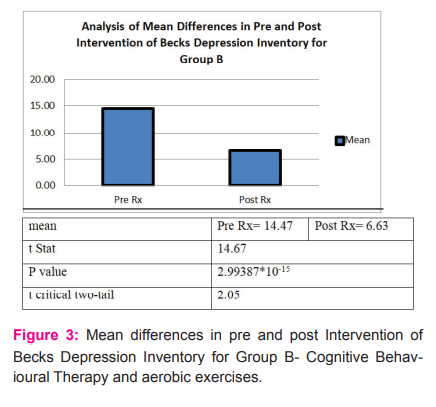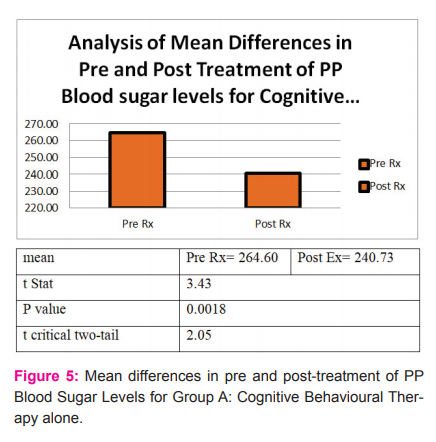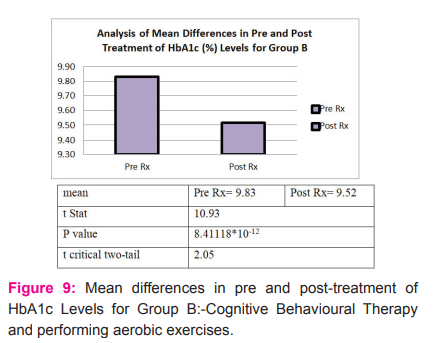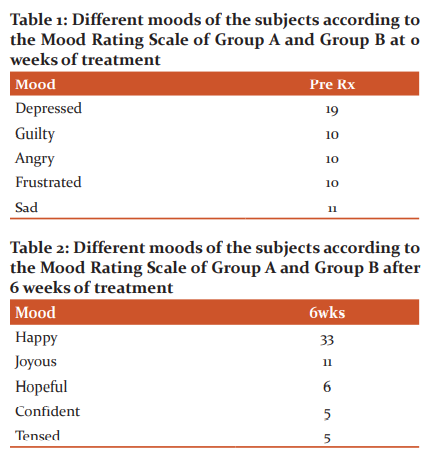IJCRR - 13(3), February, 2021
Pages: 132-138
Date of Publication: 03-Feb-2021
Print Article
Download XML Download PDF
To Study the Additional Effect of Aerobic Exercises on Cognitive Behavioral Therapy in Depressed Diabetics
Author: Ronika Agrawal, Arwa Alirajpurwala
Category: Healthcare
Abstract:Introduction: Depression has been linked to abnormal glucose metabolism in diabetics by increasing insulin resistance. Cognitive behavioural therapy is commonly used psychotherapeutic approaches for reducing depression. It is usually time-limited, focuses on current problems and follows a structured style of intervention. Objective: To test the effectiveness of cognitive-behavioural therapy alone and along with aerobic exercises in reducing depression and to find its effect on blood sugar levels. To study the additional effect of aerobic exercises on cognitive behavioural therapy in depressed diabetics. Methods: Sixty diabetic patients were selected having a score of >11 on Becks Depression Inventory (Age 35-60 years). HbA1c equal to or more than 8%, diabetic for more than two years. Patients were grouped (N=30/group) to receive cognitive behavioural therapy or cognitive behavioural therapy + aerobic exercises. The level of depression was evaluated using Becks Depression Inventory, postprandial blood sugar levels and glycated haemoglobin( HbA1c) levels were measured pre and post 6 weeks. The mood of patients was assessed using mood rating scale pre and post-intervention. Cognitive behavioural therapy was given for 6 weeks and results were analyzed. Results: A significant reduction was seen in depression, postprandial blood sugar levels and HbA1c levels in both the groups. There was also an improvement in the mood of the patients from depression to joyful over 6 weeks. Conclusion: Both aerobic exercises and cognitive behavioural therapy proved to be effective in reducing depression and thereby optimizing blood sugar levels and HbA1c levels.
Keywords: Diabetes Mellitus Type II, Cognitive Behavioral Therapy, Depression, Becks Depression Inventory, Aerobic Exercises, Insulin resistance
Full Text:
INTRODUCTION
Diabetes mellitus is defined as a metabolic disorder of multiple aetiology, characterized by chronic hyperglycemia with disturbances of carbohydrate, protein and fat metabolism resulting from defects in insulin secretion, insulin action, or both.1 Diabetes Mellitus has become one of the most common chronic diseases worldwide with an estimated prevalence of detected Diabetes Mellitus being 3 to 4% in the general population. One of the consistent findings among various studies on diabetes has been the high prevalence of depression with or without comorbid anxiety among patients of Diabetes Mellitus.2 Also it has been found that depression is consistently associated with hyperglycemia and an increase in the risk of diabetic complications.3
Depression leads to deterioration of glycemic control via its effects on the neuroendocrine system.2 The presence of microvascular and macrovascular complications in diabetes is associated with a higher prevalence of depression and a lower quality of life.1 Remission of depression is often associated with an improvement in glycemic control. Various randomized trials of treatments for depression have been conducted in patients with diabetes. These interventions have successfully reduced the severity of depression and optimizing glycemic levels.1
A variety of methods are adopted to deal with stressors and depression-like anger management, aversion treatment, relaxation training, social skills training, and stress management. One of these psychotherapeutic treatment includes Cognitive Behavioral Therapy (CBT)4. The first controlled outcome study of cognitive behavioural therapy for depression was conducted in 1977 and since then a great deal of research into the effectiveness of Cognitive Behavioral Therapy has been conducted. Currently, cognitive behavioural therapy is in common use throughout the world, within public and private health care services, and particularly in the US, Canada, UK, Australia and Northern Europe. 5
Cognitive behavioural therapy is a psychological treatment that addresses the interactions between how we think, feel and behave. It is usually time-limited, focuses on current problems and follows a structured style of intervention.5 A systematic review evaluated the impact of cognitive behavioural therapy on glycemic control of people with type 2 diabetes where there was a reduction of 0.76% in HbA1c levels, thus suggesting the importance of cognitive behavioural therapy in treating depression among diabetics.1
Brief cognitive behavioural therapy is the compression of cognitive-behavioural therapy material and the reduction of the average 12-20 sessions into four to six sessions. In Brief cognitive behavioural therapy, the concentration is on specific treatments for a limited number of the patient’s problems. Time-limited therapy offers an additional incentive for patients and therapists to work efficiently and effectively. However, the exact length of treatment is determined by a host of factors involving the therapist, patient, and treatment setting. 6
Cognitive behavioural therapy includes four important components.
-
Progressive Muscle Relaxation Techniques: Muscle relaxation for all muscles is given.
-
Behavioural Activation: People are taught to engage in enjoyable activities and improve their problem-solving skills.
-
Mental Imagery: Patient is asked to imagine a peaceful atmosphere while watching a Relaxing video and oft music.
-
Deep Breathing Exercises
All these are progressively taught during each cognitive behavioural therapy session.
Exercise, along with diet and medication, plays an important role in the management of type 2 diabetes. Aerobic exercise consists of exercises of the same large muscle groups for at least 20 minutes at a time. Examples include walking, bicycling, jogging, swimming, etc When performed at sufficient intensity and frequency, this type of exercise increases cardiorespiratory fitness. Regular aerobic exercise decreases visceral fat mass and body weight without affecting muscle mass, increases insulin sensitivity, glucose and blood pressure control, lipid profile improves and reduces the cardiovascular risk. For these reasons, regular aerobic physical activity must be considered an essential component of the treatment of type II diabetes mellitus.7
As we know that cognitive-behavioural therapy has proven to effective intervention for reducing depression and enhancing glycemic control, with enduring and clinically meaningful benefits in adults with type 2 diabetes and depression.8 And aerobic exercises help in increasing insulin sensitivity thus lowering high blood sugar levels.7,9 A combined effect of both aerobic exercises and cognitive behavioural therapy would thus give us an integrated approach in managing diabetics suffering from depression.
MATERIALS AND METHODS
After receiving approval from the Institutional Ethics Committee, patients were selected based on inclusion and exclusion criteria. A brief explanation of the procedure was given to each subject. Patients were asked to sign a written consent before their participation. Patients were then asked to fill the demoFigure ic datasheet.
Subjects in the age group 35-60 years, diabetic for at least 2 years or more, HbA1c equal to or more than 8% within the last 1-1.5 months or average blood sugar level (BSL) of at least 183 mg /dl, Becks depression inventory score10 of at least 11 or more signifying mild to borderline clinical levels of depression, subjects not participating in any exercises for last 3 months or more and subjects who could understand English were included in the study.
Subjects having cognitive dysfunctions like schizophrenia, dementia, any psychiatric illnesses, any musculoskeletal or neurological deficits were excluded. Patients were also given the mood rating scale, behavioural activation chart and a calendar for marking the days they performed the exercises.
The following procedure was carried out with every patient. (each session represents a week)
Session 1
-
Identify her presenting problem.
-
Introduce cognitive behavioural therapy.
-
Set goals.
-
Introduce behavioural activation.
-
Introduce and practise progressive muscle relaxation.
-
Receive feedback from the patient.
Session 2
-
Check mood.
-
Review behavioural activation
-
Plan two times during the week to practice progressive muscle relaxation & introduce deep breathing exercises (DBE) & imagery.
-
Receive feedback from the patient.
Session 3
-
Check mood.
-
Review progressive muscle relaxation, behavioural activation, DBE & imagery.
-
Review homework.
-
Ask him to practice progressive muscle relaxation & imagery exercise
-
Receive feedback from the patient.
Session 4
-
Check mood.
-
Review PMR, Behavioral activation, DBE, imagery
-
Review homework.
-
Receive feedback from the patient.
Session 5
-
Check mood.
-
Review homework.
-
Review PMR, behavioural activation, imagery & DBE
-
Review the progress of treatment by 2 imagery ex
-
Receive feedback from the patient.
Session 6
AEROBIC EXERCISES
-
Before beginning with aerobic exercises, patients were asked to check their heart rate (radial pulse) by placing index, middle and ring finger on their wrist.
-
Their resting heart rate and target heart rate was calculated for using Karvonen’s formula.
-
The warm-up was given by asking the patient to start walking slowly & gradually increase the speed.
-
Frequency = 5 times a week
-
Intensity = For the first 2 weeks patients walked at 30% of Heart Rate (HR) max and for the remaining 4 weeks, they walked between 40% - 60% of HR max.
-
Time = 30 minutes
-
Type = Walking at a faster pace than normal
206.9 – (0.7 * age)
Karvonen’s formula (THR) = (HR max – HR rest) 30% - 60% + HR rest
RESULTS AND DISCUSSION
A significant reduction was seen in depression, postprandial blood sugar levels and HbA1c levels in both the groups. There was also an improvement in the mood of the patients from depression to joyful over 6 weeks.
This study aimed at finding the additional effect of aerobic exercises on cognitive behavioural therapy in depressed diabetics. Diabetic patients of age between 35-65 years were part of the study. Patients were selected from various residential areas including Camp, Kondhwa, Hadapsar and City areas in and around Pune. Patients who were having no cognitive dysfunctions like schizophrenia or dementia and without any innate or acquired musculoskeletal or neurological deficits were selected.
In our study, we used the Becks Depression Inventory where the levels of depression in both groups ranged from 11 to 20 which indicates mild to borderline clinical levels of depression. There is a significant difference in the Becks Depression Inventory in Pre and Post-treatment score in group A thus showing a reduction in depression levels in the subjects of this group (Figure 2).
In Figure 3, the mean difference between pre and post-treatment values for Becks Depression Inventory for group A and group B are 7.60 and 7.83 respectively, with a p-value of 0.74 concluding that both forms of treatment that is, cognitive behavioural therapy alone and in combination with aerobic exercises have reduced depression levels in diabetic patients but no one group is better than other.
Cognitive behavioural therapy is increasingly being identified as one of the best forms of therapy for conditions like depression, anxiety and stress which attempts to find links between the person’s feelings and the patterns of thinking which predict their depression.4-6 Progressive muscle relaxation began from research that a psychobiological state called neuromuscular hypertension is the basis for a lot of negative emotional states. According to Jacobson relaxation of muscles will make way for a relaxation of mind “because an emotional state fails to exist in presence of complete relaxation of peripheral parts involved”. Progressive Muscle Relaxation helps to increase the frequency of alpha waves in the brain which are responsible for reducing stress and depression by reducing muscular tension and inducing relaxation.13
Deficiency of monoamines i.e norepinephrine, serotonin and dopamine within midbrain and brainstem nuclei lead to depression. These areas of the brain are involved in regulating mood regulation and cognition. Relaxation and deep breathing exercises release monoamines and help in enhancing mood and improving mood regulation.14 Behavioural activation includes a set of procedures and techniques aimed at increasing patient activity and access to reinforcing situations that improve mood and functioning. Activation for depression generally serves to get the patient moving. Almost all behaviours that include physical activity, planning, or accomplishing tasks are a part of behavioural activation.6
According to a study done in 2004 by Kimberly Goldapple et al, under the American Medical Association, functional MRI showed various changes in different parts of the brain in response to cognitive behavioural therapy15. For example, cognitive behavioural therapy helped in deactivating hippocampus, dorsolateral, medial frontal and ventral prefrontal cortex areas of the brain which are responsible for encoding and retrieval of maladaptive associate memories. There was also a reduction in both ruminations and over-processing of irrelevant information.15,16
Mental imagery helps in activating the prefrontal cortex, ventral cingulated cortex, dorsal cingulated cortex and amygdala all of which are responsible for changing the subject’s affective state. Mental imagery reduces the amygdala-hippocampus hyperactivation which is involved in the generation of negative moods, thus reducing anxiety, depression and other abnormal behaviors.15 According to Figure 4, the mean for pre and post-treatment values for Post Prandial (PP) blood sugar levels in group A is 264.60 and 240.73 respectively, with a p-value of 0.0018. Similarly, in Figure 5 the mean for pre and post-treatment values for PP blood sugar levels in group B is 238.67 and 220.67 respectively, with a p-value of 0.00041 indicating a significant reduction in PP blood sugar levels post-treatment in both the groups. There is a significant difference in the PP Blood Sugar Levels in Pre and Post-treatment values in group A thus showing a reduction in Blood Sugar Levels in the subjects of this group. In Figure 6, the mean difference in the pre and post-treatment results of PP blood sugar levels between group A and group B is 23.87 and 18 respectively with a p-value of 0.48. This showed a reduction in Blood Sugar Levels in the subjects of this group. In Figure 7 the pre-treatment value for HbA1c is 10.49% which reduced to 10.17% post-treatment for group A. There is no difference in the Pre and Post-treatment means in both the groups and thus both forms of treatment show statistical significance. According to Figure 8, the pre-treatment value for HbA1c in group B is 9.83% which reduced to 9.52% post-treatment. There is a significant difference in the HbA1c Levels in Pre and Post-treatment means in group A thus showing a reduction in HbA1c Levels in the subjects of this group.
In Figure 9 and 10 there is a mean difference of 0.01 in HbA1c in two groups with a p-value of 0.93 showing statistically insignificance between the two groups. Thus, there is a significant reduction seen in the HbA1c values for both the groups indicating that both forms of treatment show good effects.
Several studies have reported common biologic substrates in diabetes and depression. Alterations in the activity of the hypothalamic-pituitary-adrenal axis such as increases in cortisol production have been observed in individuals with diabetes. Excess of cortisol leads to depression. Also, there are alterations seen in the metabolism of neurotransmitters, particularly norepinephrine and serotonin.
An increase in the blood supply of the working limb causes an increase in glucose uptake thus maintaining optimum glucose levels within the muscle. Thus more the activity of the muscle, more the blood supply and more will be the increase in glucose metabolism. Exercise and insulin stimulate glucose utilization synergistically. The primary route of insulin-mediated glucose metabolism at rest and in the post-exercise state is non-oxidative metabolism. Hemodynamic adjustments cause an increase in capillary surface area in working muscle thus, increasing the availability of insulin. Exercises also increase insulin-stimulated glucose metabolism. Insulin action is also directly enhanced at working muscle by activation of post insulin receptor signalling which further helps in increasing glucose uptake.9
In people with type II diabetes, physical training (aerobic exercises) increases insulin-stimulated nonoxidative glucose disposal presumably activating glycogen synthesis. The beneficial effects of regular physical activity on insulin sensitivity appear to be the final result of the sum of specific effects of exercise on glucose transporter 4 (GLUT 4) content, oxidative capacity and capillary density of skeletal muscle. Preliminary data suggest that insulin-independent glucose transport, induced by exercise, is promoted by augmented endothelial and muscle production of nitric oxide. Since impaired nitric oxide production often complicates type 2 diabetes mellitus, physical exercise might be utilized to improve as well as insulin sensitivity and endothelial dysfunction.7 Thus, blood sugar levels optimize by exercises in people with type II diabetes.
Cognitive Behavioural Therapy helps in developing a relevant response to emotional and environmental stimuli and at cortical level helps in reducing the retrieval of abnormal thoughts and insignificant information, thus enhancing the mood of the patients.
Behavioural Activation which is a part of Cognitive Behavioural Therapy is very useful for depressed mood. Re-introducing pleasant events (one form of behavioural activation) can serve to improve mood in many different ways - 1) reversing avoidance, 2) increasing physical activity, 3) increasing self-confidence and 4) increasing feelings of usefulness
and purpose. Recent empirical evidence suggests that behavioural interventions improve mood symptoms and also reduce maladaptive thought patterns. 6 Also, Cognitive Behavioural Therapy seems to affect clinical recovery by modulating the functions of specific sites in limbic and cortical regions of the brain targeting the areas responsible for the change in mood thus acting as an antidepressant. 15
Since in CBT, the patient is an active member of the intervention, he is aware of the disease process and means to control the disease. By this, we are educating the patient and making him take care of his disease. Cognitive Behavioural Therapy (CBT) is an effective intervention for adherence, depression, and glycemic control, with enduring and clinically meaningful benefits for diabetes self-management and glycemic control in adults with type 2 diabetes and depression.8
A systematic review found robust data demonstrating that engagement in diabetes self-management education results in a statistically significant decrease in A1C levels.17 Diabetes self-management education in conjunction with primary care is effective in improving glycemic control in Hispanic adults with type 2 Diabetes Mellitus.18 CBT had better efficacy in improving depression symptoms of patients with diabetes compared with routine approaches.19 The quality of life of the middle-class Indian population as per SF-36 scoring is around 75 on 100. Mental Component Summary scores are better than Physical Component Summary scores (Table 1 and 2).20 By combining Aerobic exercise and cognitive behavioural therapy we can aspire to reach the quality of life as near to the normal population. By CBT we are working on the mental well being and with aerobic exercise, we are taking care of physical well being.
CONCLUSION
We conclude that Cognitive Behavioural Therapy alone or in combination with aerobic exercises lead to a reduction in depression levels among diabetics and helps in reducing their postprandial blood sugar levels and HbA1c levels. Cognitive Behavioural therapy reduces depression in diabetic patients.
ACKNOWLEDGEMENT: We thank wholeheartedly all the subjects for participating in our study. Authors acknowledge the immense help received from the scholars whose articles are cited and included in references to this manuscript. The authors are also grateful to authors/editors/publishers of all those articles, journals and books from where the literature for this article has been reviewed and discussed.
Conflict of Interest: Nil
Financial Assistance: Nil








References:
-
Ismail K, Winkley K, Rabe-Hesketh S. Systematic review and meta-analysis of randomised controlled trials of psychological interventions to improve glycaemic control in patients with type 2 diabetes. Lancet 2004;363(9421):1589-1597.
-
Dhavale HS, Panikkar V, Jadhav BS, Ghulghule M, Agari AD. Depression and diabetes: impact of antidepressant medications on glycaemic control. J Assoc Physicians India 2013;61(12):896-899.
-
Gonzalez JS, Esbitt SA, Schneider HE, Osborne PJ, Kupperman EG. Psychological issues in adults with type 2 diabetes. In Psychological Co-Morbidities of physical illness 2011 (pp. 73-121). Springer, New York, NY.
-
Rector NA. Cognitive behavioural therapy: An information guide. Centre for Addiction and Mental Health; 2000.
-
Somers J, Querée M. Cognitive behavioural therapy: core information document. Centre for Applied Research in Mental Health and Addictions, Simon Fraser University; 2007. 148 p.
-
Jeffrey A. Cully, Andra L. Teten. A Therapist’s Guide To Brief Cognitive Behavioral Therapy. Houston (USA): Department of Veterans Affairs; 2008.
-
De Feo P, Di Loreto C, Ranchelli A, Fatone C, Gambelunghe G, Lucidi P, Santeusanio F. Exercise and diabetes. Acta Biomed 2006;77(1):14-7.
-
Safren SA, Gonzalez JS. A randomized controlled trial of cognitive-behavioural therapy for adherence and depression (CBT-AD) in patients with uncontrolled type 2 diabetes. Diabetes Care 2014;37(3):625-633.
-
Ronald J. Sigal, Glen Kenny, David H. Wasserman, Carmen Castaneda-Seppa. Physical Activity/ Exercise and Type 2 Diabetes. Diabetes Care 2004;27(10):2520-2521.
-
Cousin C, Yang H, Yeung A, Fava M. Rating scales for depression. In Handbook of clinical rating scales and assessment in psychiatry and mental health. Humana Press, Totowa, NJ.2009; pp. 7-35
-
Gellish RL, Goslin BR, Olson RE. Longitudinal modelling of the relationship between age and maximal heart rate. Med Sci Sports Exercise 2007;39(5):822-829.
-
Ignaszewski M, Lau B, Wong S, Isserow S. The science of exercise prescription: Martti Karvonen and his contributions. Br Columbia Med J 2017;59(1).
-
Ranjita L, Sarada N. Progressive muscle relaxation therapy in anxiety: a neurophysiological study. J Dent Med Sci 2014;13(2):25-28.
-
Arya A, Verma P. A review of pathophysiology, classification and long term course of depression. Int Res J Pharmacy 2012;3(3):90-96.
-
Goldapple K, Segal Z, Garson C, Lau M, Bieling P, Kennedy S, Mayberg H. Modulation of cortical-limbic pathways in major depression: treatment-specific effects of cognitive behaviour therapy. Arch Gen Psychia 2004;61(1):34-41.
-
Collerton D. Psychotherapy and brain plasticity. Front Psychol 2013;4:548.
-
Chrvala CA, Sherr D, Lipman RD. Diabetes self-management education for adults with type 2 diabetes mellitus: a systematic review of the effect on glycemic control. Patient Educ Counsel 2016;99(6):926-943.
-
Ferguson S, Swan M, Smaldone A. Does diabetes self-management education in conjunction with primary care improve glycemic control in Hispanic patients? A systematic review and meta-analysis. Diabetes Educator 2015;41(4):472-484.
-
Wang ZD, Xia YF, Zhao Y, Chen LM. Cognitive behavioural therapy on improving the depression symptoms in patients with diabetes: a meta-analysis of randomized control trials. Biosci Rep 2017;37(2).
-
Agrawal R, D’Silva C. Assessment of quality of life in normal individuals using the SF36 questionnaire. Int J Cur Res Rev 2017;9:43-47.
|






 This work is licensed under a Creative Commons Attribution-NonCommercial 4.0 International License
This work is licensed under a Creative Commons Attribution-NonCommercial 4.0 International License